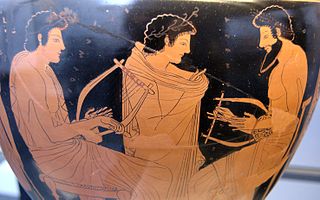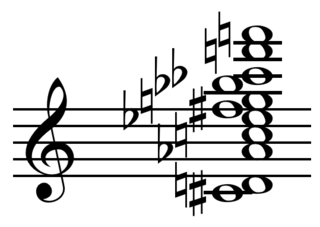

In music a mixed-interval chord is a chord not characterized by one consistent interval. Chords characterized by one consistent interval, or primarily but with alterations, are equal-interval chords. Mixed interval chords "lend themselves particularly" to atonal music since they tend to be dissonant. [2]

Music is an art form and cultural activity whose medium is sound organized in time. General definitions of music include common elements such as pitch, rhythm, dynamics, and the sonic qualities of timbre and texture. Different styles or types of music may emphasize, de-emphasize or omit some of these elements. Music is performed with a vast range of instruments and vocal techniques ranging from singing to rapping; there are solely instrumental pieces, solely vocal pieces and pieces that combine singing and instruments. The word derives from Greek μουσική . See glossary of musical terminology.

A chord, in music, is any harmonic set of pitches consisting of multiple notes that are heard as if sounding simultaneously. For many practical and theoretical purposes, arpeggios and broken chords, or sequences of chord tones, may also be considered as chords.
In music theory, an interval is the difference in pitch between two sounds. An interval may be described as horizontal, linear, or melodic if it refers to successively sounding tones, such as two adjacent pitches in a melody, and vertical or harmonic if it pertains to simultaneously sounding tones, such as in a chord.

Equal-interval chords are often of indeterminate root and mixed-interval chords are also often best characterized by their interval content. [2] "Equal-interval chords are often altered to make them 'impure' as in the case of quartal and quintal chords with tritones, chords based on seconds with varying intervals between the seconds." [2]

In music theory, the concept of root is the idea that a chord can be represented and named by one of its notes. It is linked to harmonic thinking— the idea that vertical aggregates of notes can form a single unit, a chord. It is in this sense that one speaks of a "C chord" or a "chord on C"—a chord built from "C" and of which the note "C" is the root. When a chord is referred to in Classical music or popular music without a reference to what type of chord it is, it is assumed a major triad, which for C contains the notes C, E and G. The root need not be the bass note, the lowest note of the chord: the concept of root is linked to that of the inversion of chords, which is derived from the notion of invertible counterpoint. In this concept, chords can be inverted while still retaining their root.
In music, quartal harmony is the building of harmonic structures built from the intervals of the perfect fourth, the augmented fourth and the diminished fourth. For instance, a three-note quartal chord on C can be built by stacking perfect fourths, C–F–B♭.
In music theory, the tritone is defined as a musical interval composed of three adjacent whole tones. For instance, the interval from F up to the B above it is a tritone as it can be decomposed into the three adjacent whole tones F–G, G–A, and A–B. According to this definition, within a diatonic scale there is only one tritone for each octave. For instance, the above-mentioned interval F–B is the only tritone formed from the notes of the C major scale. A tritone is also commonly defined as an interval spanning six semitones. According to this definition, a diatonic scale contains two tritones for each octave. For instance, the above-mentioned C major scale contains the tritones F–B and B–F. In twelve-equal temperament, the tritone divides the octave exactly in half.









